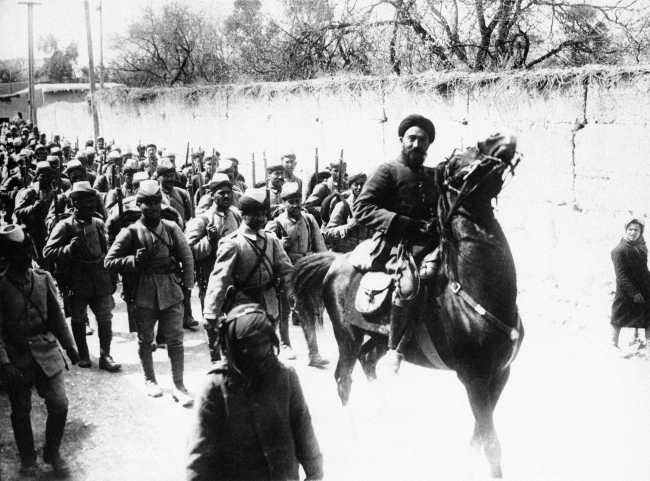Удивительный мир Сирии первой половины XX века в фотографиях
- 20 октября 2015 00:27
- Ольга Манолова
Ниже подборка фотографий из жизни сирийцев с начала XX века и до середины сороковых годов.

Турецкие военные в Дамаске. 01/01/1914.

Демонстрация палестинских мигрантов в Дамаске, на которую пришли 10 тысяч беженцев (всего их в Сирии было около 48 тысяч). Участники акции хотели выразить благодарность сирийским военным за содействие во время столкновений на границе с Израилем. Также палестинские мигранты изъявили желание быть принятыми добровольцами в сирийскую армию, чтобы они смогли принять участие в очередном отпоре Израилю, который и стал виновником их несчастий и решения покинуть родину. На фотографии пожилая женщина обращается с речью к палестинским арабам с призывом к действию. 01/04/1929.

Герберт Гувер, 31-й американский президент от Республиканской партии, и его жена стоят на мосту во время своего визита в Сирию. 02/08/1930.

Типичный для древнего сирийского города Телль-Биса пейзаж, 1936 год.

Повседневная жизнь в древнем городе Телль-Биса. Сирийская деревня была построена полностью из дерева и грязи по причине нехватки каменного материала. 22/05/1936.

Группа еврейских колонистов с винтовками в руках на страже палестино-сирийской границы. Забор с колючей проволокой протяженностью в пятьдесят миль был поврежден из-за мародерства арабов, что вынудило местную полицию вооружиться и открыть огонь. Город страдал от столкновений в течение всего июля. 20/07/1938.

Пропускной пункт из Сирии в Палестину. На контроле стоят французские и британские силы, по причине того, что тайно тысячи арабских повстанцев из Ливана и Сирии оказались на Святой Земле.

Франция и Турция пришли к военному соглашению относительно Санджака в Александрии, территории между азиатской Турцией и Сирией, чтобы обеспечить внутреннюю безопасность. Соглашением было установлено, что 2500 тысяч человек из французских войск и столько же из турецких будут находиться на территории Санджака (количество военных, не считая сирийских). На фотографии жители аплодируют турецким солдатам, вошедшим в город 1 июля 1938 года. Улицы и фасады домов были помечены символикой красного флага с белым полумесяцем, которого они не видели на своей территории на протяжении двадцати лет. 01/07/1938.

Начиная с глубокой древности, в Сирии и других засушливых странах Ближнего Востока волов используют для транспортировки воды к оросительной системе. Та же атрибутика, что и в библейские времена.

Караван верблюдов транспортирует соль из рек и морей древней Сирии к соляной горе в Алеппо.


Американские еврейские колонисты в Палестине строят пограничный с Сирией забор. Установка этого забора — часть плана Британии по урегулированию конфликта на сирийской границе.

Араб стоит около колючей стены в Израиле, воздвигнутой по решению сэра Чарльза во избежание мародерства арабов из Палестины. Сооружение этого забора стоило пятьсот тысяч долларов.

Фахри Нашашиби (влиятельный оппонент палестинского национализма, организатор так называемых отрядов мира в период арабских волнений в Палестине в 1936—1939 годах) оспаривает лидерство бывшего муфтия Амин аль-Хусейна, изгнанного из Сирии. Нашашиби, человек от одной из самых выдающихся родословных в Палестине, говорил, что Амин аль-Хусейн не пророк, но самопровозглашенный политик, который продвигал в стране свою кампанию террора. На фотографии Фахри в Палестине. 24/11/1938.

Фахри Нашашиби в центре.

Вид на старый город Дамаска, декабрь 1938 года.

Шесть колонн в развалинах храма Юпитера рядом с городом Баальбек. Раньше это место считалось одним из чудес света. 1938 год.

Сирийский мастер в древней лавке в Дамаске, 1938 год.

Внутри Мечети Омейядов, также известной как Большая мечеть Дамаска, одной из крупнейших и старейших мечетей в мире. Расположена в одном из самых священных мест в старом городе Дамаска, представляет собой большую архитектурную ценность. Мечеть содержит сокровищницу, в которой, как говорят, находится голова Иоанна Крестителя (Яхья), почитаемого пророком как христианами, так и мусульманами. Голова, возможно, была найдена во время раскопок при строительстве мечети. В мечети также находится могила Салах-ад-Дина, расположенная в небольшом саду, примыкающему к северной стене мечети.

Гора Acora, известная вершина в северо-западной Сирии, недалеко от знаменитого библейского города Антиохии, где апостол Павел проповедовал Евангелие. Древние видели в контуре снежных покровов очертания лика и придавали им таинственные силы.

Ливанские горы, расположенные к северу от Палестины, известны своими величественными кедрами. Этот снимок стал рождественской открыткой. 02/12/1938.

Неутвержденный франко-сирийский договор привел к массовым забастовкам в Дамаске против подобной политики. Демонстранты требовали роспуска правительства страны. На фотографии лидер сирийской оппозиции выступает с балкона своего дома перед народом. 23/01/1939.

Бывший начальник Генерального штаба французской армии и заместитель председателя Высшего военного совета Максим Вейган. В 1935 году Вейган ушел в отставку, а в 1940-м снова призван к службе в должности верховного командующего французской армии, но в конце 1941-го по требованию Гитлера отправлен в отставку вновь. Слева на фотографии президент Республики Ливан Эмиль Эдде.

Наследный принц Ирана Мохаммеда Реза Пехлеви прибыл в Каир, чтобы жениться на египетской принцессе Фавзии Фауд (сестра короля Египта Фарука). Он плыл на египетской королевской яхте из Бейрута в Александрию через Дамаск в сопровождении военно-морского флота.

Французские военные власти установили контроль над Дамаском из-за всеобщей забастовки и отставки правительства. Колючая проволока, военная охрана, баррикады — главные атрибуты Дамаска во время военного контроля. 29/03/1939.
.
Тысячи армянских беженцев пришли в Сирию из Санджака Искендеруна во время турецкой оккупации. Вместе с беженцами шли противники правительства Анкары того времени. Многие мигранты поджигали свои дома, только чтобы те не попали в руки турецких солдат. 02/08/1939.
- Телеграм
- Дзен
- Подписывайтесь на наши каналы и первыми узнавайте о главных новостях и важнейших событиях дня.



Войти через социальные сети: